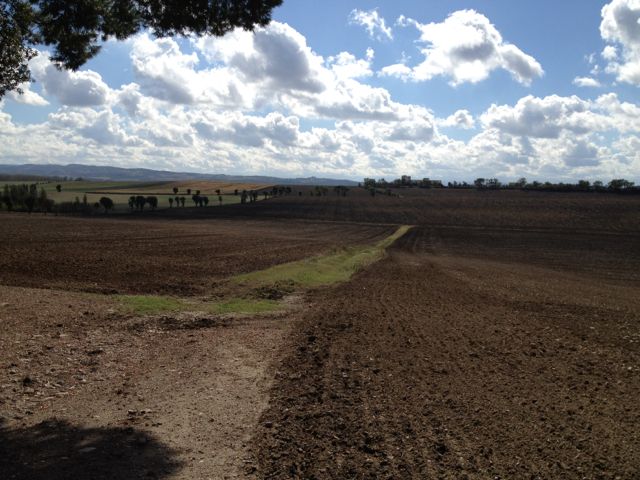When we arrived back in mid August the bloom of summer was nearing its end and the fields of baked dry earth was evidence of how hot summer can be. The sunflowers had mostly finished their glorious show of yellow and had their heads bowed as if in prayer ; the wheat had been harvested and only the dry stalks and stubble were left but the vines were a show of verdant green with masses of bunches of white or purple grapes.
The chateau itself was also cloaked in vibrant green of the ivy and virginia creeper that adorns some of its walls while the lawns were dry and brown in many places and the flowers in the garden were past their best showing.
Now, over two months on, the colours around the chateau and in the fields beyond its walls are the colours of autumn. It is not an autumn palette as one finds in some places such as in the South Island or in the states of Connecticut and New England, rather it is a palette of more muted colour.
 |
| About 15 minutes from the chateau |
Along with the change of colour come other signs that point to the change of season.
 The temperatures are slowly getting cooler although there are still days of Indian summer weather which are getting fewer and fewer; Monsieur Gaspard - our chateau squirrel has been seen again and the moles are on the move with little mole hills reappearing in the lawn. These will continue to appear right through the winter as moles seem to be notorious at evading any human attempt to thwart their progress. For such little creatures they certainly can make their presence known.
The temperatures are slowly getting cooler although there are still days of Indian summer weather which are getting fewer and fewer; Monsieur Gaspard - our chateau squirrel has been seen again and the moles are on the move with little mole hills reappearing in the lawn. These will continue to appear right through the winter as moles seem to be notorious at evading any human attempt to thwart their progress. For such little creatures they certainly can make their presence known. |
| Near by woods seen from the chateau tower |
 |
| Across the road from the chateau |
 |
| The view from the tower |
 Fields from the gates of the chateau |
In the fields around the chateau and beyond, farmers are busy preparing for crops to be planted before the winter comes. The last of the sunflowers have been harvested. The earth has been tilled and ploughed and rich dark brown fields replace the sandy coloured stubble of wheat and the dry stalks of the sunflowers. Nothing remains of the summer crops.
Most of the vines are now stripped of their grapes and the leaves are beginning to change colour and starting to fall. Before too long the vineyards will be rows of bare vines awaiting pruning that will happen in the depth of winter.

Knowing very little about farming of any kind, I do not know what crops will be sown this season. Except in one field, in fact the first field as you leave the village, onions have been planted. Whole onions, rows and rows, lie uncovered. I presume they will be covered in due course - but as I said I am not a farmer! However I do know that these onions are female and the rows still empty will have male onions planted in them. Once they have grown they will be left to seed but only the seeds from the female plants will be harvested to produce seed stock. I know this because one of our good friends here in Raissac is in the farming and seed producing business. And here I thought an onion was an onion was an onion!
As well as the countryside the chateau too is becoming part of the autumn palette.
The ivy and creeper are turning from the vibrant summer green to a glorious array of red, yellow and orange. In a few weeks the 'rainfall of leaves' should start - it is quite a sight to see hundreds, if not thousands, of leaves falling off the vines.

Another autumn sight are the chestnut trees. There are no edible chestnuts in the chateau grounds but the horse chestnuts are a beautiful colour ....of chestnut. Winter is the time for roasted chestnuts - such a yummy smell in the Christmas markets... and yummy to eat too.
Photos do not do justice to the colors of the countryside. It is so hard to capture all the shades that are there. The vastness of the countryside is also hard to capture.
But I do hope that this post will give you a little idea of all this autumn beauty we are so fortunate to be able to experience.
So from a very autumnal Raissac sur Lampy until the next time
Au revoir.






















